Metastatic Melanoma Drugs Market Size
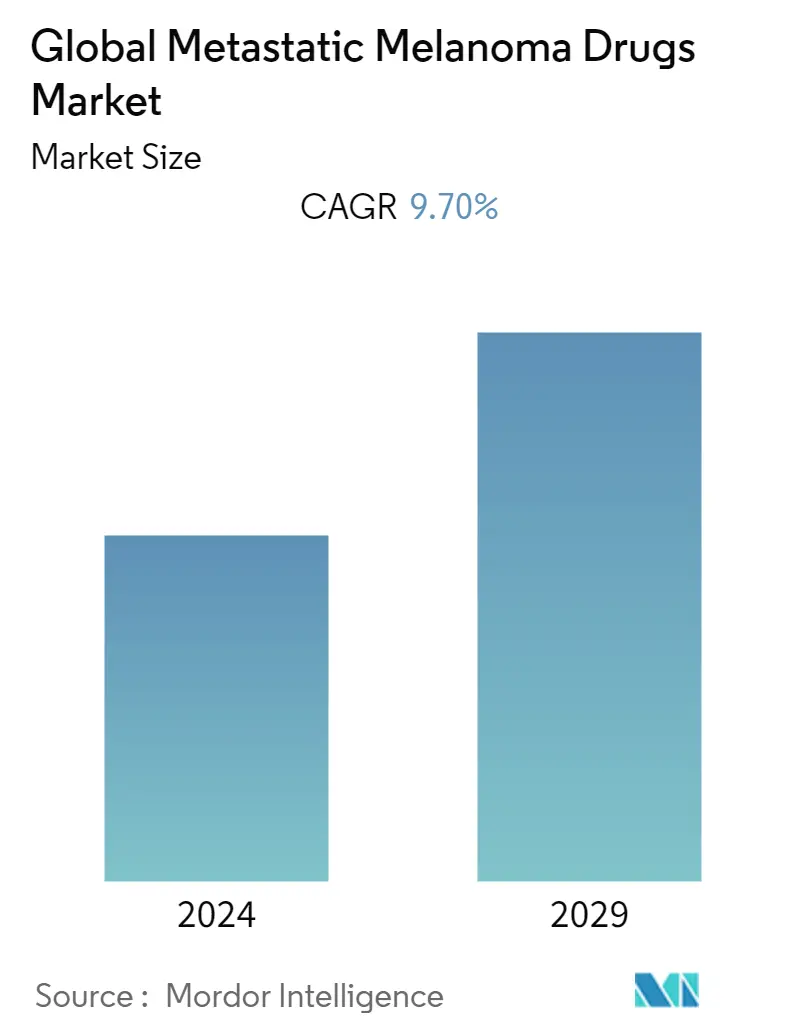
| Study Period | 2019 - 2029 |
| Base Year For Estimation | 2023 |
| Forecast Data Period | 2024 - 2029 |
| CAGR | 9.70 % |
| Fastest Growing Market | Asia-Pacific |
| Largest Market | North America |
Major Players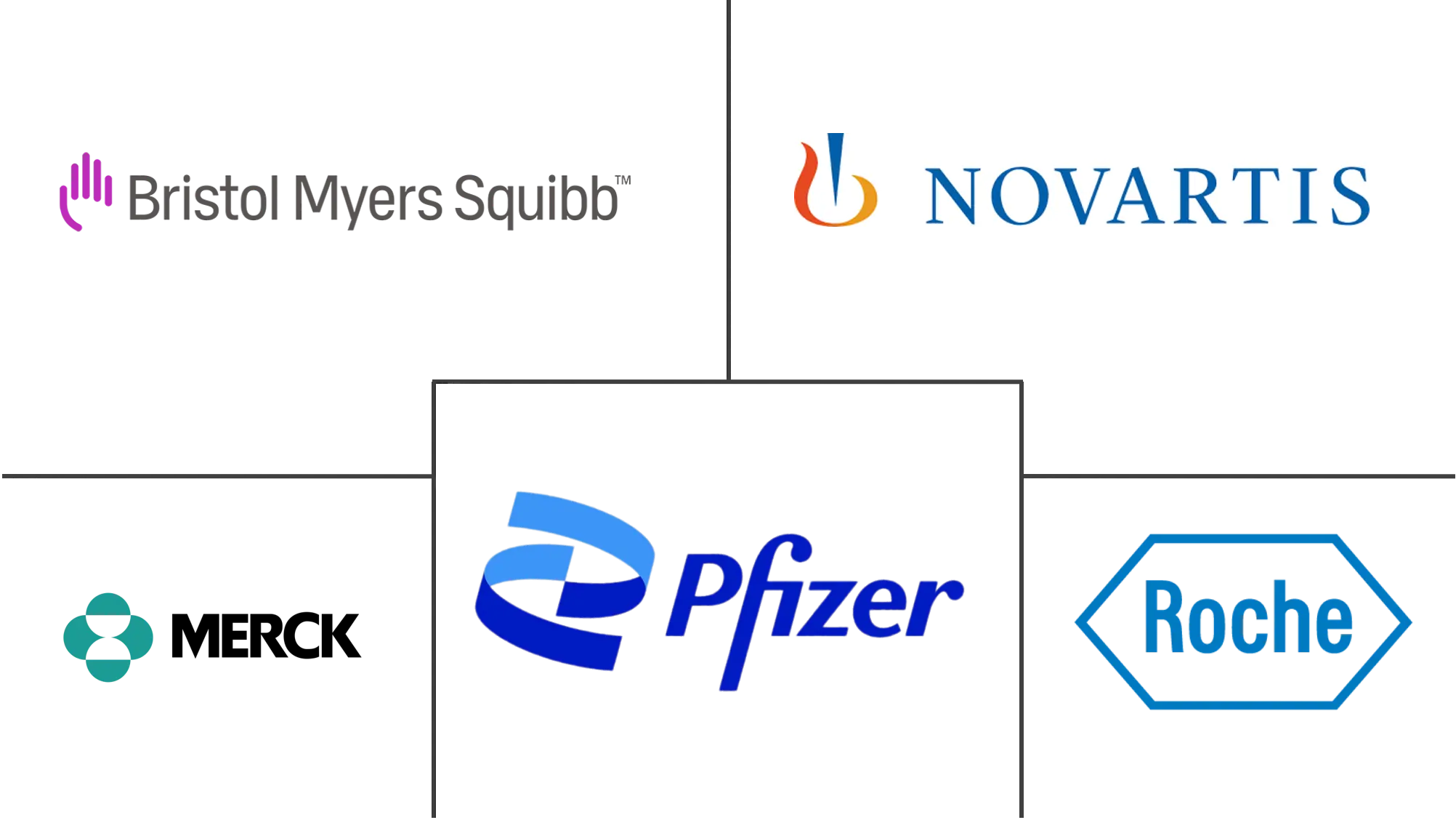
*Disclaimer: Major Players sorted in no particular order |
Metastatic Melanoma Drugs Market Analysis
The metastatic melanoma drugs market is expected to register a CAGR of 9.7% over the forecast period, 2022-2027.
COVID-19 pandemic has had a substantial impact on the metastatic melanoma drugs market initially. The strict lockdowns and government regulations intended to slow down the spread of COVID-19 resulted in a decrease in the treatment of cancer patients in hospitals and clinics, which includes metastatic melanoma patients as well. However, the sales of home-use metastatic melanoma drugs observed a significant increase during the pandemic. For instance, a cohort study was conducted for evaluating the impact of the covid-19 pandemic on melanoma and non-melanoma skin cancer inpatient treatment in Germany. It was published in May 2022 in the Journal of the European Academy of Dermatology and Venereology (JEADV) and the results of the study showed that since the beginning of the pandemic there has been a significant drop in the number of hospital admissions and surgical procedures for skin cancer patients. Furthermore, according to the article titled 'Melanoma Management during the COVID-19 Pandemic Emergency: A Literature Review and Single-Center Experience' published in the journal of National Center for Biotechnology Information (NCBI) in December 2021, a case study was performed where they compared the early diagnosis rate of melanoma in 2020 to that of 2018 and 2019 and a decrease in the early diagnoses of melanoma was observed during the pandemic; however, surgical interventions and systemic treatments for advanced cases were guaranteed. Thus, the COVID-19 outbreak affected the market's growth adversely in its preliminary phase; however, the market is expected to gain traction as the pandemic subsides eventually.
Further, the increasing incidence of metastatic melanoma, technological advancements for the treatment of metastatic melanoma and rising development of new biologics are among the major factors driving the growth of the studied market. Currently, factors such as rising exposure to ultraviolet rays, rising depletion of the ozone layer and increasing working hours in airplanes are also responsible for the increasing incidence of metastatic melanoma cases. Such factors are likely to boost the usage of metastatic melanoma drugs, thereby contributing to the studied market growth.
Moreover, according to an article titled 'Epidemiology of Melanoma' published in the journal of National Centre for Biotechnology Information (NCBI) in October 2021 worldwide incidence of melanoma has risen over the past few decades. The Annual incidence of melanoma is rising at a rapid rate of 4-6% in white-skinned populations in regions like North America, Europe, Australia, and New Zealand. Furthermore, according to the American Cancer Society, Inc. by the end of the year 2022 there will be 99,780 new cases of melanoma, and 7,650 people are expected to die due to melanoma in the United States. Therefore, the use of drugs that will be used to treat the patients affected with metastatic melanoma is poised to accelerate the metastatic melanoma drugs market globally and is expected to increase in the future, thereby driving the growth of the studied market over the forecast period.
In addition, new product launches and strategic activities by major players in the market are positively affecting the growth of the studied market. For instance, in June 2022 Immunocore collaborated with Sanofi to evaluate Sanofi's product candidate SAR444245, non-alpha IL-2, in combination with Kimmtrak in patients with metastatic cutaneous melanoma. Additionally, in April 2022 Pfizer Inc. offered an independent medical education grant for the best practices in the clinical management of patients with BRAF-mutant metastatic melanoma. Thus, owing to the launches and partnerships the studied market is further expected to have significant growth over the forecast period.
Therefore, owing to the aforementioned factors the studied market is anticipated to witness growth over the analysis period. However, the high risk of side effects associated with the treatment procedure and high cost of treatment are likely to impede market growth.
Metastatic Melanoma Drugs Market Trends
This section covers the major market trends shaping the Metastatic Melanoma Drugs Market according to our research experts:
Immunotherapy Drugs Segment is Expected to Witness Growth Over the Forecast Period
Immunotherapy drugs are promising new drugs which use proteins on immune cells as checkpoints to start or boost the immune response of the patient. They also prevent the patient's own immune system to attack normal or healthy cells. Moreover, according to Memorial Sloan Kettering Cancer Center, immunotherapy drugs have proven to be very effective against metastatic melanoma which cannot be removed completely by surgery as immunotherapy drugs empower the immune system to recognize and fight cancer, unlike other therapies which directly attack cancer cells causing severe side effects. Unlike chemotherapy, which acts directly on cancerous tumors, immunotherapy treats patients by acting on their immune system. Immunotherapy can boost the immune response in the body as well as teach the immune system how to identify and destroy cancer cells, thus having less side effects than chemotherapy. Hence, owing to the advantages offered by immunotherapy drugs, the adoption of these products is likely to increase among the target population, ultimately driving the market growth.
In addition, according to the report titled 'Immunotherapy in the Treatment of Metastatic Melanoma: Current Knowledge and Future Directions' by the journal of NCBI published in 2020, stated that the introduction of immunotherapy drugs has completely changed the approach for the treatment of metastatic melanoma. Additionally, it was also mentioned that studies have proven the increase of PD-1 in melanoma, which means a strong downregulation of activated T cells that helps the maintenance of tumor cells so in the future immunotherapy with anti-PD1 antibodies-based drugs will also prove to be effective. Thus, the increasing adoption of immunotherapy drugs creates demand for technically advanced immunotherapy-based drugs and is creating opportunities for the growth of the segment in the future.
Furthermore, continuous Food and Drug Administration (FDA) approvals of products by major players in the market are positively affecting the growth of the segment. For instance, in December 2021 Merck & Co., Inc., announced that the FDA has approved Keytruda, Merck's anti-PD-1 therapy, (FDA) to treat adults and children ages 12 and older with stage IIB or IIC melanoma after they've undergone surgery to remove their tumors. Further, in May 2021 Bristol-Myers Squibb Company announced new six-and-a-half-year data from CheckMate-067, a randomized, double-blind, Phase 3 clinical trial, demonstrating durable improvement in survival with first-line Opdivo (nivolumab) plus Yervoy (ipilimumab) therapy and Opdivo monotherapy, versus Yervoy alone, in patients with advanced melanoma.
Therefore, the immunotherapy drugs segment is expected to witness significant growth over the forecast period due to the abovementioned factors.
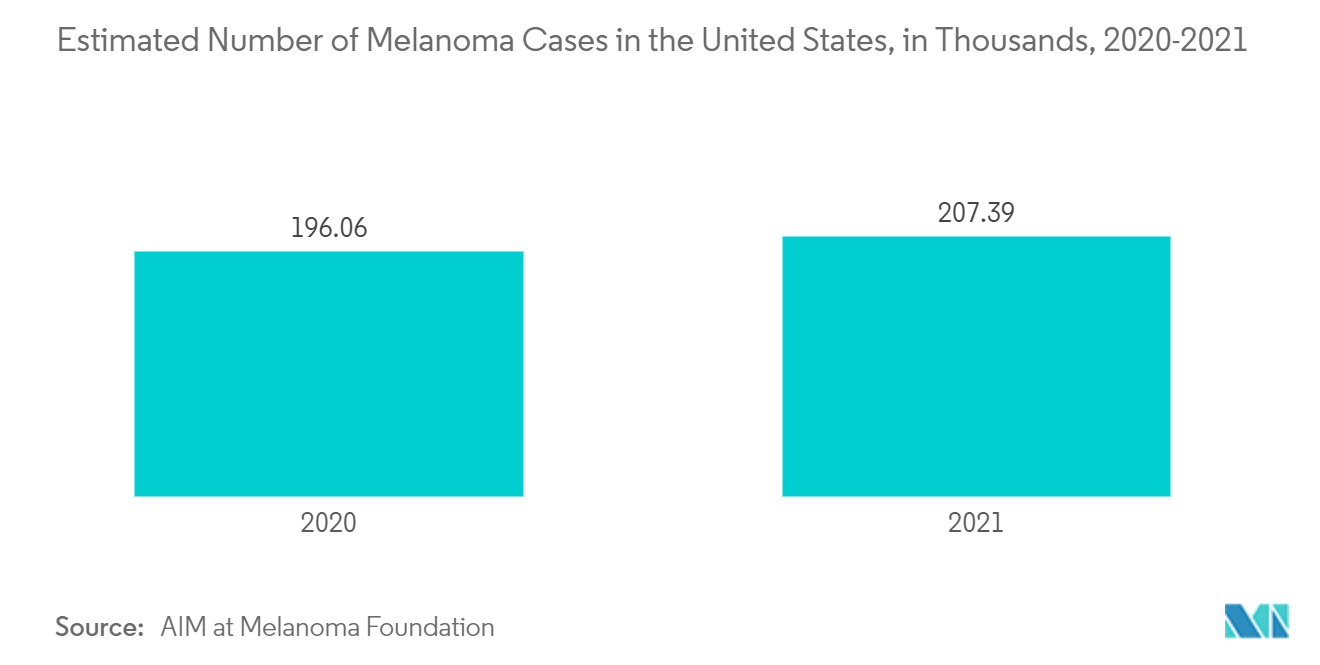
North America Dominates the Metastatic Melanoma Drugs Market
North America is expected to dominate the market owing to factors such as the easy availability of technologically advanced drugs, high prevalence of metastatic melanoma, and high awareness among patients about metastatic melanoma in the region. For instance, according to the American Cancer Society, Inc. melanoma is more than 20 times more common in white Americans than in African Americans. Overall, the lifetime risk of getting melanoma is about 2.6 percent. An increase in the usage of drug-based therapies for rapid and effective results in the United States is among the key factors which contribute to the growth of the studied market in North America.
Key research and development activities, high concentration of market players, or manufacturer's presence in the United States are some of the factors driving the growth of the metastatic melanoma drugs market in the country. For instance, In March 2021 Bristol-Myers Squibb Company, a United States-based company announced the primary results from the Phase 2/3 RELATIVITY-047 (CA224-047) trial evaluating the fixed-dose combination of relatlimab, an anti-LAG-3 antibody, and Opdivo (nivolumab) versus Opdivo alone in patients with previously untreated metastatic or unresectable melanoma. Moreover, in October 2021 Merck & Co., Inc., a United States based company announced new data from studies evaluating KEYTRUDA, Merck's anti-PD-1 therapy, at the Society for Melanoma Research (SMR) 2021 Congress. This study was based on patients with metastatic melanoma.
Therefore, owing to the aforesaid factors the studied market is anticipated to show promising growth in the North America Region.
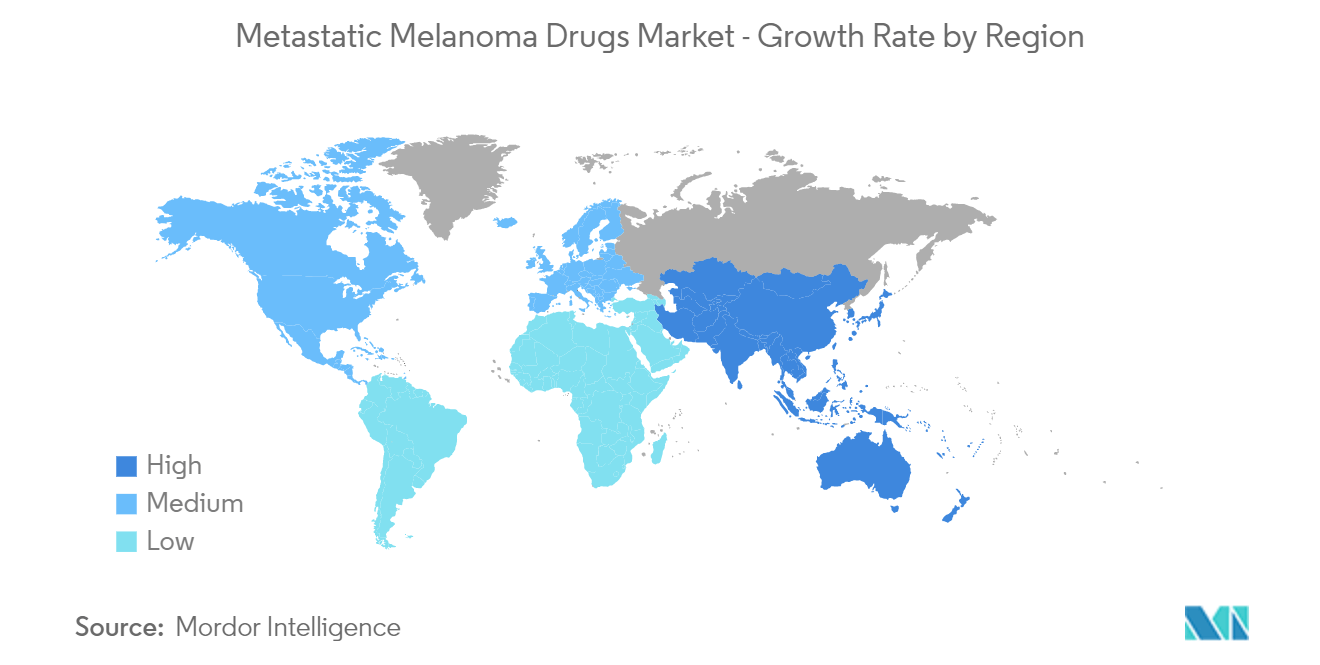
Metastatic Melanoma Drugs Industry Overview
The metastatic melanoma drugs market is fragmented in nature due to the presence of several companies operating globally as well as regionally. The competitive landscape includes an analysis of a few international as well as local companies which hold the market shares and are well known. include Bristol-Myers Squibb Company, Novartis AG, Merck & Co., Inc., F. Hoffmann-La Roche Ltd, Amgen, Inc., AstraZeneca, Pfizer Inc., Sanofi, Accord Healthcare, and Amneal Pharmaceuticals LLC., among others.
Metastatic Melanoma Drugs Market Leaders
-
Bristol-Myers Squibb Company
-
Pfizer Inc.
-
Novartis AG
-
Merck & Co., Inc.
-
F. Hoffmann-La Roche Ltd
*Disclaimer: Major Players sorted in no particular order
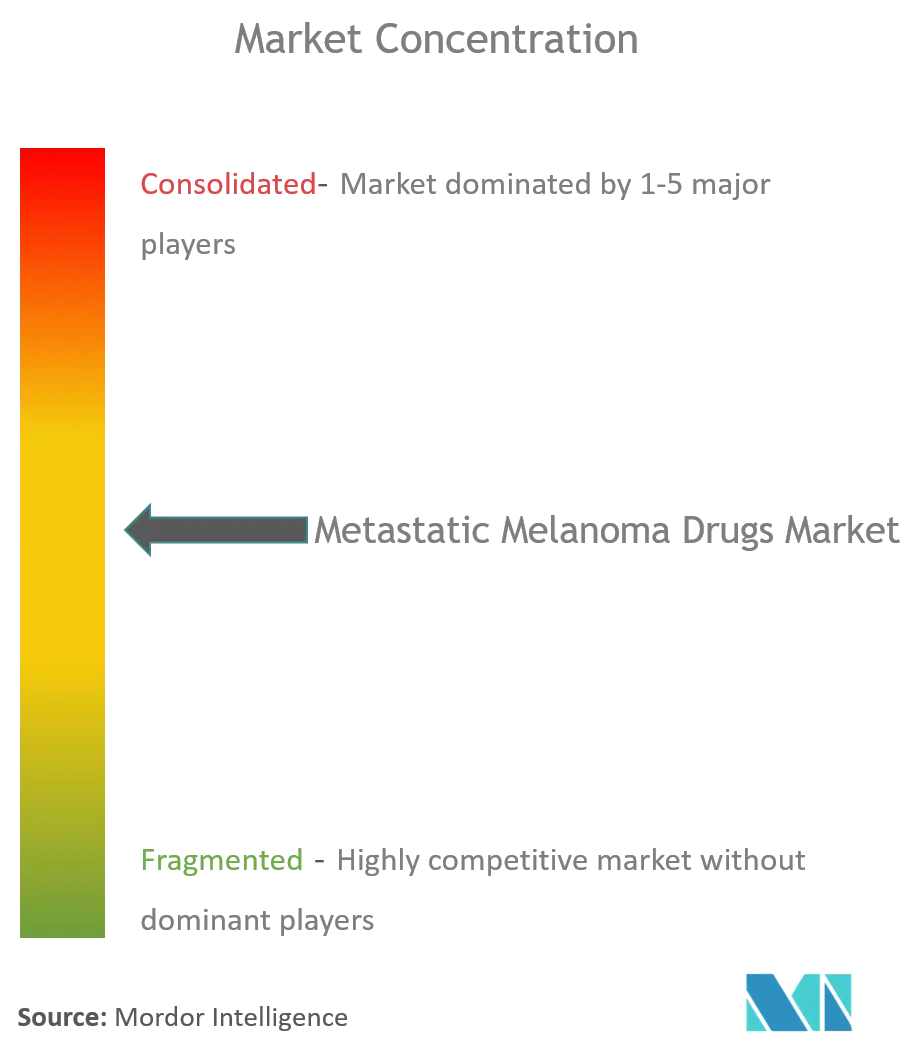
Metastatic Melanoma Drugs Market News
- In July 2022, Bristol-Myers Squibb Company, announced that the Committee for Medicinal Products for Human Use (CHMP) of the European Medicines Agency (EMA) has recommended approval of the fixed-dose combination of nivolumab and relatlimab for the first-line treatment of advanced (unresectable or metastatic) melanoma in adults and adolescents 12 years of age and older.
- In March 2022, Nektar Therapeutics and Bristol Myers Squibb Company announced an update following the first analysis of the Phase 3 PIVOT IO-001 study evaluating the doublet therapy of bempegaldesleukin in combination with Opdivo (nivolumab) compared to Opdivo monotherapy as a first-line treatment for previously untreated unresectable or metastatic melanoma.
Metastatic Melanoma Drugs Market Report - Table of Contents
1. INTRODUCTION
1.1 Study Assumptions and Market Definition
1.2 Scope of the Study
2. RESEARCH METHODOLOGY
3. EXECUTIVE SUMMARY
4. MARKET DYNAMICS
4.1 Market Overview
4.2 Market Drivers
4.2.1 Increasing Incidence of Metastatic Melanoma
4.2.2 Technological Advancements for The Treatment of Metastatic Melanoma
4.2.3 Rising Development of New Biologics
4.3 Market Restraints
4.3.1 High Risk of Side Effects Associated with the Treatment Procedure
4.3.2 High Cost of Treatment
4.4 Porter's Five Force Analysis
4.4.1 Threat of New Entrants
4.4.2 Bargaining Power of Buyers/Consumers
4.4.3 Bargaining Power of Suppliers
4.4.4 Threat of Substitute Products
4.4.5 Intensity of Competitive Rivalry
5. MARKET SEGMENTATION (Market Size by Value - USD million)
5.1 By Drug Type
5.1.1 Chemotherapy Drugs
5.1.2 Immunotherapy Drugs
5.1.3 Targeted Therapy Drugs
5.2 By End-User
5.2.1 Hospitals
5.2.2 Specialty Clinics
5.2.3 Other End-Users
5.3 Geography
5.3.1 North America
5.3.1.1 United States
5.3.1.2 Canada
5.3.1.3 Mexico
5.3.2 Europe
5.3.2.1 Germany
5.3.2.2 United Kingdom
5.3.2.3 France
5.3.2.4 Italy
5.3.2.5 Spain
5.3.2.6 Rest of Europe
5.3.3 Asia-Pacific
5.3.3.1 China
5.3.3.2 Japan
5.3.3.3 India
5.3.3.4 Australia
5.3.3.5 South Korea
5.3.3.6 Rest of Asia-Pacific
5.3.4 Middle East and Africa
5.3.4.1 GCC
5.3.4.2 South Africa
5.3.4.3 Rest of Middle East and Africa
5.3.5 South America
5.3.5.1 Brazil
5.3.5.2 Argentina
5.3.5.3 Rest of South America
6. COMPETITIVE LANDSCAPE
6.1 Company Profiles
6.1.1 Bristol-Myers Squibb Company
6.1.2 Novartis AG
6.1.3 Merck & Co., Inc.
6.1.4 F. Hoffmann-La Roche Ltd
6.1.5 Amgen, Inc.
6.1.6 AstraZeneca
6.1.7 Pfizer Inc.
6.1.8 Sanofi
6.1.9 Accord Healthcare
6.1.10 Amneal Pharmaceuticals LLC.
- *List Not Exhaustive
7. MARKET OPPORTUNITIES AND FUTURE TRENDS
Metastatic Melanoma Drugs Industry Segmentation
As per the scope of the report, metastatic melanoma is a disease that occurs when the cancerous cells from the original tumor (primary tumor) get loose, spread by traveling through the lymph or blood circulation, and start a new tumor (metastatic tumor) somewhere else. The metastatic melanoma drugs are used to treat patients who are suffering from this advanced stage of melanoma. The metastatic melanoma drugs market is segmented by drug type (chemotherapy drugs, immunotherapy drugs, and targeted therapy drugs), end-user (hospitals, specialty clinics, and other end-users), and Geography (North America, Europe, Asia-Pacific, Middle East and Africa, and South America). The market report also covers the estimated market sizes and trends for 17 different countries across major regions, globally. The report offers the value (in USD million) for the above segments.
| By Drug Type | |
| Chemotherapy Drugs | |
| Immunotherapy Drugs | |
| Targeted Therapy Drugs |
| By End-User | |
| Hospitals | |
| Specialty Clinics | |
| Other End-Users |
| Geography | ||||||||
| ||||||||
| ||||||||
| ||||||||
| ||||||||
|
Metastatic Melanoma Drugs Market Research FAQs
What is the current Global Metastatic Melanoma Drugs Market size?
The Global Metastatic Melanoma Drugs Market is projected to register a CAGR of 9.70% during the forecast period (2024-2029)
Who are the key players in Global Metastatic Melanoma Drugs Market?
Bristol-Myers Squibb Company, Pfizer Inc., Novartis AG, Merck & Co., Inc. and F. Hoffmann-La Roche Ltd are the major companies operating in the Global Metastatic Melanoma Drugs Market.
Which is the fastest growing region in Global Metastatic Melanoma Drugs Market?
Asia-Pacific is estimated to grow at the highest CAGR over the forecast period (2024-2029).
Which region has the biggest share in Global Metastatic Melanoma Drugs Market?
In 2024, the North America accounts for the largest market share in Global Metastatic Melanoma Drugs Market.
What years does this Global Metastatic Melanoma Drugs Market cover?
The report covers the Global Metastatic Melanoma Drugs Market historical market size for years: 2019, 2020, 2021, 2022 and 2023. The report also forecasts the Global Metastatic Melanoma Drugs Market size for years: 2024, 2025, 2026, 2027, 2028 and 2029.
Global Metastatic Melanoma Drugs Industry Report
Statistics for the 2024 Global Metastatic Melanoma Drugs market share, size and revenue growth rate, created by Mordor Intelligence™ Industry Reports. Global Metastatic Melanoma Drugs analysis includes a market forecast outlook to 2029 and historical overview. Get a sample of this industry analysis as a free report PDF download.



